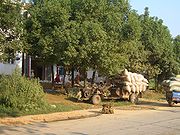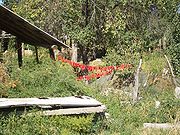
Postharvest
Encyclopedia

Agriculture
Agriculture is the cultivation of animals, plants, fungi and other life forms for food, fiber, and other products used to sustain life. Agriculture was the key implement in the rise of sedentary human civilization, whereby farming of domesticated species created food surpluses that nurtured the...
, postharvest handling is the stage of crop
Crop (agriculture)
A crop is a non-animal species or variety that is grown to be harvested as food, livestock fodder, fuel or for any other economic purpose. Major world crops include maize , wheat, rice, soybeans, hay, potatoes and cotton. While the term "crop" most commonly refers to plants, it can also include...
production immediately following harvest
Harvest
Harvest is the process of gathering mature crops from the fields. Reaping is the cutting of grain or pulse for harvest, typically using a scythe, sickle, or reaper...
, including cooling, cleaning, sorting and packing. The instant a crop is removed from the ground
Soil
Soil is a natural body consisting of layers of mineral constituents of variable thicknesses, which differ from the parent materials in their morphological, physical, chemical, and mineralogical characteristics...
, or separated from its parent plant
Plant
Plants are living organisms belonging to the kingdom Plantae. Precise definitions of the kingdom vary, but as the term is used here, plants include familiar organisms such as trees, flowers, herbs, bushes, grasses, vines, ferns, mosses, and green algae. The group is also called green plants or...
, it begins to deteriorate. Postharvest treatment largely determines final quality, whether a crop is sold for fresh
Freshness
Freshness may refer to:* Post harvest freshness* Freshness , a 1995 album by Casiopea* Freshness , certainty that replayed messages in a replay attack on a protocol will be detected as such...
consumption, or used as an ingredient in a processed food product.
Goals

Sanitation
Sanitation is the hygienic means of promoting health through prevention of human contact with the hazards of wastes. Hazards can be either physical, microbiological, biological or chemical agents of disease. Wastes that can cause health problems are human and animal feces, solid wastes, domestic...
is also an important factor, to reduce the possibility of pathogen
Pathogen
A pathogen gignomai "I give birth to") or infectious agent — colloquially, a germ — is a microbe or microorganism such as a virus, bacterium, prion, or fungus that causes disease in its animal or plant host...
s that could be carried by fresh produce, for example, as residue from contaminated
Contamination
Contamination is the presence of a minor and unwanted constituent in material, physical body, natural environment, at a workplace, etc.-Specifics:"Contamination" also has more specific meanings in science:...
washing water.
After the field, post-harvest processing is usually continued in a packing house
Packing house
A packing house is a facility where fruit is received and processed prior to distribution to market.Bulk fruit is delivered to the plant via trucks or wagons, where it is dumped into receiving bins and sorted for quality and size...
. This can be a simple shed, providing shade and running water, or a large-scale, sophisticated, mechanized
Mechanization
Mechanization or mechanisation is providing human operators with machinery that assists them with the muscular requirements of work or displaces muscular work. In some fields, mechanization includes the use of hand tools...
facility, with conveyor belt
Conveyor belt
A conveyor belt consists of two or more pulleys, with a continuous loop of material - the conveyor belt - that rotates about them. One or both of the pulleys are powered, moving the belt and the material on the belt forward. The powered pulley is called the drive pulley while the unpowered pulley...
s, automated
Automation
Automation is the use of control systems and information technologies to reduce the need for human work in the production of goods and services. In the scope of industrialization, automation is a step beyond mechanization...
sorting and packing stations, walk-in cooler
Cooler
A cooler, cool box, portable ice chest, chilly bin , or esky most commonly is an insulated box used to keep food or drink cool. Ice cubes are most commonly placed in it to help the things inside stay cool...
s and the like. In mechanized harvesting, processing may also begin as part of the actual harvest process, with initial cleaning and sorting performed by the harvesting machinery.
Initial post-harvest storage conditions are critical to maintaining quality. Each crop has an optimum range for storage temperature and humidity. Also, certain crops cannot be effectively stored together, as unwanted chemical interactions can result. Various methods of high-speed cooling, and sophisticated refrigerated
Refrigeration
Refrigeration is a process in which work is done to move heat from one location to another. This work is traditionally done by mechanical work, but can also be done by magnetism, laser or other means...
and atmosphere-controlled environments, are employed to prolong freshness, particularly in large-scale operations.
Regardless of the scale of harvest, from domestic garden to industrialized farm, the basic principles of post-harvest handling for most crops are the same: handle with care to avoid damage (cutting, crushing, bruising), cool immediately and maintain in cool conditions, and cull (remove damaged items).
Postharvest Shelf Life
Once harvested, vegetable and fruit are subject to the active process of senescenceSenescence
Senescence or biological aging is the change in the biology of an organism as it ages after its maturity. Such changes range from those affecting its cells and their function to those affecting the whole organism...
. Numerous biochemical processes
Biochemistry
Biochemistry, sometimes called biological chemistry, is the study of chemical processes in living organisms, including, but not limited to, living matter. Biochemistry governs all living organisms and living processes...
continuously change the original composition of the crop
Crop (agriculture)
A crop is a non-animal species or variety that is grown to be harvested as food, livestock fodder, fuel or for any other economic purpose. Major world crops include maize , wheat, rice, soybeans, hay, potatoes and cotton. While the term "crop" most commonly refers to plants, it can also include...
until it becomes unmarketable. The period during which consumption is considered acceptable is defined as the time of "postharvest shelf life".
Postharvest shelf life is typically determined by objective methods that determine the overall appearance, taste, flavor, and texture of the commodity. These methods usually include a combination of sensorial
Sensory analysis
Sensory analysis is a scientific discipline that applies principles of experimental design and statistical analysis to the use of human senses for the purposes of evaluating consumer products. The discipline requires panels of human assessors, on whom the products are tested, and recording the...
, biochemical
Biochemistry
Biochemistry, sometimes called biological chemistry, is the study of chemical processes in living organisms, including, but not limited to, living matter. Biochemistry governs all living organisms and living processes...
, mechanical, and colorimetric (optical) measurements. A recent study attempted (and failed) to discover a biochemical marker
Marker
Marker may refer to:* Marker , a morpheme that indicates some grammatical function* Marker , a special-purpose computer* A set of sewing patterns tightly arranged within a rectangle that is placed over cloth to be cut...
and fingerprint methods
Peptide mass fingerprinting
Peptide mass fingerprinting is an analytical technique for protein identification that was developed in 1993 by several groups independently. In this method, the unknown protein of interest is first cleaved into smaller peptides, whose absolute masses can be accurately measured with a mass...
as indices
Index
Index may refer to:-Business:* Index , a defunct UK catalogue retailer formerly owned by the Littlewoods group and known as Littlewoods Index* INDEX, a market research fair in Lucknow, India* Index fund, a collective investment scheme...
for freshness .
Postharvest Physiology
Postharvest physiology is the scientific study of the physiologyPhysiology
Physiology is the science of the function of living systems. This includes how organisms, organ systems, organs, cells, and bio-molecules carry out the chemical or physical functions that exist in a living system. The highest honor awarded in physiology is the Nobel Prize in Physiology or...
of living plant tissues after they have denied further nutrition by picking. It has direct applications to postharvest handling in establishing the storage and transport conditions that best prolong shelf life.
An example of the importance of the field to post-harvest handling is the discovery that ripening of fruit can be delayed, and thus their storage prolonged, by preventing fruit tissue respiration. This insight allowed scientists to bring to bear their knowledge of the fundamental principles and mechanisms of respiration, leading to post-harvest storage techniques such as cold storage, gaseous storage, and waxy skin coatings. Another well known example is the finding that ripening may be brought on by treatment with ethylene
Ethylene
Ethylene is a gaseous organic compound with the formula . It is the simplest alkene . Because it contains a carbon-carbon double bond, ethylene is classified as an unsaturated hydrocarbon. Ethylene is widely used in industry and is also a plant hormone...
.
External links
- Postharvest Technology Research
- Postharvest Equipment Supplier
- Postharvest Handling
- POSTHARVEST BIOLOGY AND TECHNOLOGY
- Writtle Postharvest Unit; Research & Training
- Postharvest Technology Research & Information Center
- Dixie, G.; Horticultural Marketing. FAO, Rome, 2005
- Lopez-Camelo, Andres. Manual for the preparation and sale of fruits and vegetables – from farm to market. FAO, Rome 2004
- FAO Information Network on Post-harvest Operations INPho
- Yazeed Postharvest Technology

